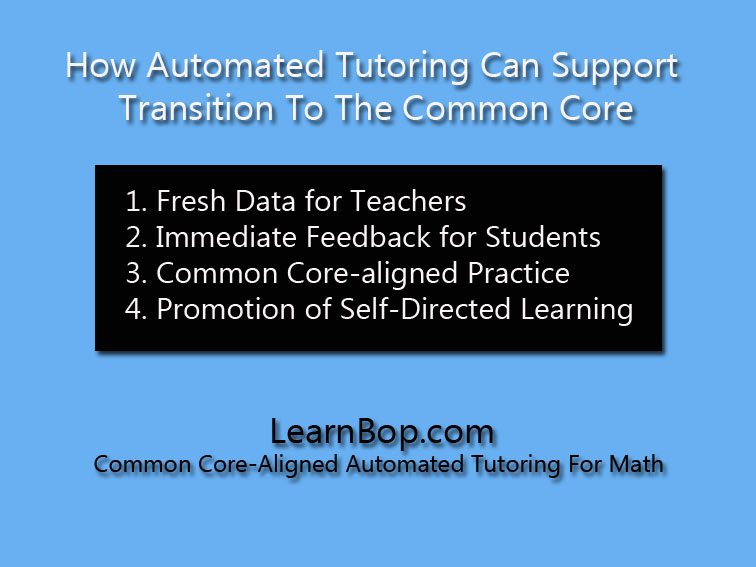 How Automated Tutoring Can Support Transition To The Common Core
How Automated Tutoring Can Support Transition To The Common Core
by Zacc Dukowitz, Learnbop.com
As the majority of states in the U.S. transition to the Common Core State Standards (CCSS), so far, test scores have plummeted. While the reality of exactly why is complicated, automated tutoring programs may be able to help, which is why we starting designing one in 2010.
In Kentucky, the first state to adopt and test for the new standards, math and reading scores dropped by approximately one third for both elementary and middle school in the 2011-2012 academic year. More recently, New York released their first set of test scores after adopting the CCSS, revealing a drop by 20% in English and 30% in mathematics. Arne Duncan, the U.S. Education Secretary, has said that these drops in test scores can be viewed as simply setting a new baseline for test scores. Some education leaders have noted that the populations whose scores dropped the most were black and Latino, leading to what has been called an increase in the achievement gap.
Regardless of how the drop in scores is viewed, the reality is that they have dropped, and will probably continue to do so if something isn’t done to support teachers in making a successful transition. The degree to which scores have dropped indicates a great need for preparation and support, both on the part of teachers, who are still learning how to teach to the new standards, and on the part of students, who are working to master the content.
What is Automated Tutoring?
Automated tutoring employs a new model of education technology, in which students are guided through the learning process, and given support so they can grow into self-directed learners. Unlike education technology programs that simply provide rote question and answer formats, automated tutoring attempts to simulate the one-on-one experience.
In a good automated tutoring program, when a student submits an incorrect answer the question being considered turns into a learning opportunity. For instance, a math problem will be broken down into its component concepts and skills, with the automated tutoring program offering suggestions and hints. A sophisticated scaffolding of visual and verbal explanations of the key concepts required will also be provided, putting all of the tools needed for moving forward into the student’s hands.
Unlike programs that emphasize memorization, an approach that only teaches students how to repeat certain actions, automated tutoring programs can help students understand underlying concepts, develop critical thinking abilities, and ultimately help them to become self-directed learners.
 3 Ways Automated Tutoring Can Support Transition To The Common Core
3 Ways Automated Tutoring Can Support Transition To The Common Core
1. By offering teachers fresh data and student immediate feedback
For teachers, automated tutoring programs can track student progress on a daily basis, providing immediate feedback on student retention and understanding. Automated tutoring programs that are fully aligned with the CCSS and provide diagnostics with CCSS data can give teachers a snapshot of class performance from one day to the next, while simultaneously giving students supplemental support in acquiring the concepts and skills needed to succeed with the new standards.
2. By offering students extra CCSS support
For students, automated tutoring programs can help ease the transition by providing supplemental instruction that is fully aligned with the CCSS. A CCSS-aligned automated tutoring program can identify the specific CCSS concepts that a student needs to work on, and follow up by providing practice problems and resources to help each student work on his or her specific knowledge gaps.
3. By supporting self-directed learning
Automated tutoring follows the model of adaptive learning, in which computer programs respond to specific student knowledge gaps, providing students with the exact support they need to move forward. As students work on problems the program engages them where they need help the most, offering hints or suggestions so that students can continue learning even when they can’t find the correct answer on their own.
Just as work with a tutor allows students to learn from their mistakes, wrong answers in an automated tutoring program become opportunities for learning. Every incorrect answer prompts the program to start a tutoring session on the concepts and skills needed to solve the problem correctly, providing work on each of these pieces until the student is ready to return to the problem.
Because automated tutoring programs have the potential to remove many of the obstacles to learning, they can be powerful tools for students to take their education into their own hands, helping them grow into self-directed learners.
LearnBop is one new automated tutoring program that is fully aligned with the CCSS for mathematics, provides in-depth diagnostic reporting for teachers, and just-in-time help for students.
To sign up for a free trial of LearnBop’s automated tutoring program, teachers can click here and parents or students can click here. The CCSS transition will continue to challenge education. There is even some evidence that Common Core may not be the answer for education moving forward. As this all sorts itself out, automated tutoring may help.
Image attribution flickr user flickeringbrad
